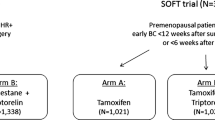Abstract
Familial ovarian cancer clinics are a recent development and little is known about the characteristics of women who attend. One hundred and ninety-seven women with a family history of ovarian cancer completed a questionnaire prior to their initial attendance at the Familial Ovarian Cancer Clinic in Edinburgh. Issues relating to screening procedures were the most commonly cited barriers to attendance, with a proportion finding gynaecological examination embarrassing (17.0%) or uncomfortable (18.0%). Expectations of the clinic were high in terms of access to resources and information. The vast majority of women would prefer to have regular screening (94.7%) and genetic testing (93.2%) if it were available. Attitudes to prophylactic surgery and chemoprevention were more diverse, but would be considered by 54.3% and 43.9% of respondents respectively. Although the current screening procedure for ovarian cancer is of unproven efficacy, a high proportion of women believed in its ability to reduce mortality (77.9%) and to detect tumours at an early stage (65.8%). There was a trend for women to believe this more strongly at follow-up. This study highlights the need to make women more aware of the limitations of current ovarian cancer screening techniques, particularly where the alternative management strategy of prophylactic surgery might otherwise be dismissed.
Similar content being viewed by others
References
Lerman C, Lustbader E, Rimer B et al. Effects of individualized breast cancer risk counseling: a randomized trial. J Nat Cancer Inst 1995; 87: 286-92.
Ritvo P, Irvine J, Robinson G et al. Psychological adjustment to familial genetic risk assessment for ovarian cancer. Psychometric Med 1997; 59: 104.
Cull A, Anderson EDC, Campbell S et al. The impact of genetic counselling about breast cancer risk on women's risk perceptions and levels of distress. Br J Cancer 1999; 79: 501-8.
Ford D, Easton DF, Bishop DT et al. Risks of cancer in BRCA1-mutation carriers. Lancet 1994; 343: 692-5.
Austoker J. Screening for ovarian, prostatic, and testicular cancers. BMJ 1994; 309: 315-20.
Bombard AT, Fields AL, Aufox S et al. The genetics of ovarian cancer: an assessment of current screening protocols and recommendations for counselling families at risk. Clin Obstet Gynecol 1996; 39: 860-72.
Michie S, Marteau TM, Bobrow M. Genetic counselling: the psychological impact of meeting patients' expectations. J Med Genet 1997; 34: 237-41.
Hallowell N, Murton F, Statham H et al. Women's need for information before attending genetic counselling for familial breast or ovarian cancer: a questionnaire, interview, and observational study. Br Med J 1997; 314: 281-3.
Julian-Reynier C, Eisinger F, Chabal F et al. Cancer genetics clinics: target population and consultees' expectations. Eur J Cancer 1996; 32A: 398-403.
Fallowfield LJ, Rodway A, Baum M. What are the psychological factors influencing attendance, non-attendance and re-attendance at a breast screening centre? J Royal Soc Med 1990; 83: 547-51.
de Koning HJ, Fracheboud J, Boer R et al. Nation-wide breast cancer screening in the Netherlands: support for breast-cancer mortality reduction. National evaluation team for breast cancer screening. Int J Cancer 1995; 60: 777-80.
Feig S. Estimation of currently attainable benefit from mammographic screening of women aged 40-49 years. Cancer 1995; 75: 2412-9.
Cooper GS, Yuan Z, Bowlin SJ et al. An ecological study of the effectiveness of mammography in reducing breast cancer mortality. Am J Public Health 1998; 88: 281-4.
Robinson GE, Rosen BP, Bradley LN et al. Psychological impact of screening for familial ovarian cancer: Reactions to initial assessment. Gynecol Oncol 1997; 65: 197-205.
Andolf E, Jorgensen C, Uddenberg N et al. Psychological effects of ultrasound screening for ovarian carcinoma. J Psychosom Obstet Gynaecol 1990; 11: 155-62.
Green J, Murton F, Statham H. Psychosocial issues raised by a familial ovarian cancer register. J Med Genet 1993; 30: 575-9.
Mackay J, Crosbie AEC, Steel CM et al. Clinical and ethical dilemmas in familial ovarian cancer. In Sharp F, Blackett A, Leake R, Berek J (eds): Ovarian Cancer 4. London: Chapman and Hall, 1995: 81-9.
Rimer BK, Schildkraut JM, Lerman C et al. Participation in a women's breast cancer risk counseling trial: Who participates? Who declines? Cancer 1996; 77: 2348-55.
Schwartz MD, Lerman C, Miller SM et al. Coping disposition, perceived risk, and psychological distress among women at increased risk for ovarian cancer. Health Psychol 1995; 14: 232-5.
Cull A, Fry A, Rush R, Steel CM. Cancer risk perceptions and distress among women attending a familial ovarian cancer clinic. Br J Cancer (In press).
Hailey BJ. Family history of breast cancer and screening behavior: an inverted U-shaped curve? Medical Hypotheses 1991; 36: 397-403.
Author information
Authors and Affiliations
Rights and permissions
About this article
Cite this article
Sheppard, R., Fry, A., Rush, R. et al. Women at risk of ovarian cancer: attitudes towards and expectations of the familial ovarian cancer clinic. Familial Cancer 1, 31–37 (2001). https://doi.org/10.1023/A:1011539800994
Issue Date:
DOI: https://doi.org/10.1023/A:1011539800994




